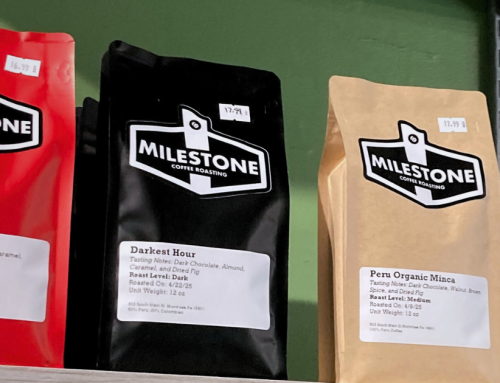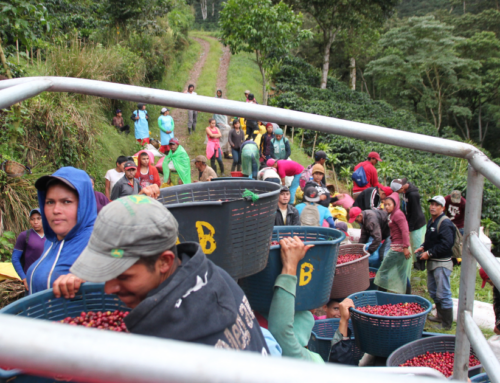Emily Smith spent several years as a quality-control manager for a large specialty roaster in Washington State before becoming an independent consultant to smaller roasters, helping them to build greens portfolios, explore purchasing options and make better decisions around pricing and logistics.
Perhaps inevitably, she’s now also roasting herself, and with a partner will soon launch a brand under a name still to be announced. So, what does an expert do, when she sets out to follow her own advice?
“I purchased a box of the Uganda Kapchorwa,” she told us.
“I reached out to the West Coast sales manager, Jen Hurd. She helped me pick out a great coffee and answered all of my questions regarding harvest and shipping dates. I wasn’t really sure about the online ordering process, but it ended up being an amazing experience that I would recommend to anyone,” said Smith.
“As a new small roaster, I can’t really forecast my usage. It was great being able to purchase a smaller quantity at a really reasonable price,” she continued, describing the process.

Emily asks: “Do you #sinar? I moisture check each sample before I sample roast, then check my end weight against mass loss to keep my samples in the same development ballpark.”
“I looked for a coffee that was freshly harvested and processed, knowing it would help me add a bit of shelf life to my green inventory. I also appreciated the ease of logistics with Genuine Origin. Often, roasters overlook the hidden time and costs involved in moving coffee from warehouses in Oakland or New Jersey to their roastery door. I also love how transparent and simple GO is with all of the pricing.”
In past jobs, Smith had lots of experience cupping coffees from mills owned by Volcafe (GO’s parent company). So she expected good quality.
“And still, it way surpassed my expectation,” she said. “I was so impressed with how clean that coffee is. That’s a beautifully milled coffee. Just beautifully milled. And, I was so impressed by how spot-on the tasting notes were. If you’re going to buy a coffee online, being able to trust the tasting notes really means a lot.”
Roaster Support
While it’s common hear about the business help producers often need, it’s less common to hear about the kind of assistance independent roasters need. So, we asked Smith to describe a few of the challenges she helps roasters to address.
Inventory management
“The thing that happens a lot, when people are starting out, is that they buy old coffee,” says Smith.
“They’re a small roaster, so they don’t quite know how much they’re going to use, or how long it will take them to buy. And someone has a spot sheet and sells them something fantastic — which, it probably was, two years ago!
“So we look at what makes sense to purchase. If you can only purchase a small amount of coffee at a time, we want to make sure you’re getting the freshest coffee you can get, and in an amount that makes sense for you.”
She gives the example of a roaster with a $1,000-a-month budget.
“First we say, how do we diversify that? So, we look for maybe a coffee with a really great acidity, and a coffee that has maybe a lot of sweetness — maybe a natural processed coffee. And also something with a heavy body. So when it all comes together, you can put together different blends, and by having high-quality coffees you can also put them as single origins in your lineup. So maybe you buy three different coffees, but you’re able to offer six coffees on your menu, between blends and single origins.”
Creating Habits
“I asked friends with roasteries: ‘Do you need any help with quality management? Or, what’s your quality program like?’ And they were like, ‘I don’t have a quality program! That’s way too much work!’” Smith laughs.
She offers the example of cupping samples.
“Say you cupped the sample and it’s one way, and it arrives and it’s totally different. What record do you have to say, ‘This is totally different’? It’s not a problem most roasters are going to deal with, but they’re not even in the mindset that there’s a value to having records.

Midnight in the lab. Photo: Emily Smith.
“It’s about creating small habits. My goal is to help roasters create the small habits that will help them to have a better handle on what they’re roasting, what their inventory is and what they’re doing.
“Coffee is just so beautiful that it can be so distracting from actually managing it!”
Added Value
“Often there’s a sales pitch that goes along with the coffee — how the coffee was milled or how the coffee was grown, or the farmer. But it gets lost. And that’s potential added value for the consumer — it helps them to connect with a coffee, beyond what they’re tasting. But often it’s information that doesn’t filter down to the wholesale account, it doesn’t filter down to the café, it doesn’t filter down to the barista, and it doesn’t filter to the customer.
“I work with them on building a quality-control system and keeping records of their coffees, so that they keep that added-value visible and work on passing it down.”
She offered the example of a green buyer with an excellent palate, debating between a coffee that’s an 86 and has a great story, and a higher-priced one that’s an 87.
“Is your consumer going to be able to appreciate the difference?” says Smith. “Can they connect with the coffee? Are your tasting notes strong enough and clear enough that they can connect with the 87? Or is it the story that will help them connect to that coffee?
“I think coffee is a really emotional thing that we tie into memory, and we tie into these potentially strong connections we can have with origin and with the farmers. It’s just something worth considering. If you think the taste alone can provide the added value, that’s awesome. But if you think the story is also an added value, you have to make sure you pass that along so it winds up with the consumer.”
Fourth Wave
Considering the changes she’s seeing, Smith is excited about the next wave in coffee.
“I think what Genuine Origin is doing, and what shared spaces like the Buckman Coffee Factory and Pulley Collective are doing is breaking down the financial barriers to coffee roasting. Which is awesome.
“The fourth wave, or whatever you want to call it, is about more community oriented, supportive environments where we’re open-sourcing information and breaking down the barriers that have kept people out of the coffee industry. The barriers that keep the barista as the barista and not as the owner. I think that’s where coffee is going.
“We need to open-source more knowledge … about green buying and green coffee in general, which has been much more closely held by the industry.”
“But! That means an influx of individuals who don’t have the same business backgrounds. It’s not going to be a bunch of old-school companies that are going to bring in business people to make sure an endeavor succeeds. So we have train our roasters and our artisans in the business skills they need, so they don’t make the mistakes that could potentially knock them out of business.
“If you look at the Portland area, all of these multi-roaster cafes are now roasting their own coffee, because there’s no barrier to it. Which is great. But we need to open-source more knowledge, and especially knowledge about green buying and green coffee in general, which has been much more closely held by the industry.” •
Questions for Emily? Reach her at emilymakescoffee@gmail.com or check out her new book and blog.
Or, click here to order samples of GO Uganda Kapchorwa.






